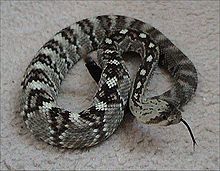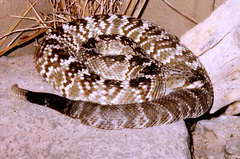- Crotalus molossus
-
Crotalus molossus 
Conservation status Scientific classification Kingdom: Animalia Phylum: Chordata Class: Reptilia Order: Squamata Suborder: Serpentes Family: Viperidae Subfamily: Crotalinae Genus: Crotalus Species: C. molossus Binomial name Crotalus molossus
Baird & Girard, 1853Synonyms - Crotalus molossus - Baird & Girard, 1853
- Crotalus ornatus - Hallowell, 1854
- Caudisona molossus - Cope, 1860
- C[audisona]. molossa - Cope, 1867
- [Crotalus durissus] Var. molossus - Garman, 1884
- Crotalus terrificus - Boulenger, 1986
- Crotalus molossus molossus - Gloyd, 1936[1]
- Common names: black-tailed rattlesnake, green rattler,[2] Northern black-tailed rattlesnake,[3] more.
Crotalus molossus is a venomous pitviper species found in the southwestern United States and Mexico. Four subspecies are currently recognized, including the nominate subspecies described here.[4]
Contents
Description
This is a medium-sized species[2] that averages 76–107 cm in length.[5] Large specimens are usually not much more than 100 cm, although lengths of 125.0 cm (Gloyd, 1940), 125.7 cm (Klauber, 1972) and 129.5 cm (Shaw & Campbell, 1974) have been reported.[2] The females tend to be larger than the males.
They range in color from olive greens, to yellows, to browns, all the way to black. As their name implies, one of their most distinguishing features is that despite variations capable in body color, the tail scales are entirely black. Often these rattlesnakes have a black band that goes across their eyes and diagonally down to the corners of their mouth forming a sort of facial 'mask'.
Like other rattlesnakes, C. molossus has a rattle composed of keratin on the end of the tail. Each time the snake sheds its skin, a new segment is added to the rattle. They can shed their skin several times a year, and the rattle is fairly fragile and can be broken, so the length of a rattlesnake's rattle is not an accurate measure of its age, unless the terminal button is intact.
Common names
Black-tailed rattlesnake, green rattler,[2] northern black-tailed rattlesnake, dog-faced rattlesnake, dog-headed rattlesnake, mountain diamondback.[3]
Geographic range
Found in the southwestern United States in Arizona, New Mexico and west and central Texas, and Mexico as far south as Oaxaca. Also found in the Gulf of California on San Estéban Island and Tiburón Island. The distribution reaches a maximum elevation of 2930 m. The type locality given is "Fort Webster, St. Rita del Cobre, N. Mex." (Fort Webster, Santa Rita del Cobre, Grant County, New Mexico, USA).[1]
Conservation status
This species is classified as Least Concern (LC) on the IUCN Red List of Threatened Species (v3.1, 2001).[6] Species are listed as such due to their wide distribution, presumed large population, or because it is unlikely to be declining fast enough to qualify for listing in a more threatened category. The population trend is stable. Year assessed: 2007.[7]
Behavior
All rattlesnakes are carnivorous, their primary food sources being rodents, other small mammals, birds, and small reptiles. The behavior of Northern black-tailed rattlesnakes varies over the course of a year. In the spring and fall they are primarily diurnal. In the summer they shift to a nocturnal behavior, to avoid the heat of summer. In the winter, they hibernate in dens created and abandoned by other animals, often with other species of snake. They are variable in their form of locomotion depending on what substrate the need to traverse and will actively change between sidewinding or rectilinear movement. Although they are able climbers and expert swimmers, C. molossus is primarily a terrestrial species and inhabits grasslands, desert areas, rocky and mountainous areas, as well as higher altitude forested habitats.
Reproduction
Breeding occurs in the spring when males follow the pheromone trails of the females. Copulation can sometimes last for hours and happen multiple times over a period of days. After mating, the male often stays near the female for several days to prevent any other males from mating with her. The female gives birth to live young in the summer months, and the babies only stay with the mother only until they wander off on their own, usually less than a day or two. Females are believed to breed every year, and can have litters as large as 10-12 young, but usually averages 4–6. Their lifespan averages 15–20 years.
Subspecies
Subspecies[4] Taxon author[4] Common name Geographic range C. m. estebanensis Klauber, 1949 San Esteban Island black-tailed rattlesnake Mexico: Isla San Esteban (Gulf of California). C. m. molossus Baird & Girard, 1853 Northern black-tailed rattlesnake United States (Arizona, New Mexico, southwest Texas), Mexico C. m. nigrescens Gloyd, 1936 Mexican black-tailed rattlesnake Mexico (South Sonora, southwest Chihuahua, southern Coahuila, south to Oaxaca and Veracruz, Tlaxcala) C. m. oaxacus Gloyd, 1948 Oaxacan black-tailed rattlesnake Mexico (Oaxaca) See also
- List of crotaline species and subspecies
- Crotalus by common name
- Crotalus by taxonomic synonyms
- Crotalinae by common name
- Crotalinae by taxonomic synonyms
- Snakebite
References
- ^ a b McDiarmid RW, Campbell JA, Touré T. 1999. Snake Species of the World: A Taxonomic and Geographic Reference, vol. 1. Herpetologists' League. 511 pp. ISBN 1-893777-00-6 (series). ISBN 1-893777-01-4 (volume).
- ^ a b c d Campbell JA, Lamar WW. 2004. The Venomous Reptiles of the Western Hemisphere. Comstock Publishing Associates, Ithaca and London. 870 pp. 1500 plates. ISBN 0-8014-4141-2.
- ^ a b Wright AH, Wright AA. 1957. Handbook of Snakes. Comstock Publishing Associates. (7th printing, 1985). 1105 pp. ISBN 0-8014-0463-0.
- ^ a b c "Crotalus molossus". Integrated Taxonomic Information System. http://www.itis.gov/servlet/SingleRpt/SingleRpt?search_topic=TSN&search_value=174314. Retrieved 24 February 2007.
- ^ Conant R. 1975. A Field Guide to Reptiles and Amphibians of Eastern and Central North America. Second Edition. First published in 1958. Houghton Mifflin Company Boston. 429 pp. 48 plates. ISBN 0-395-19979-4. ISBN 0-395-19979-8 (pbk.).
- ^ Crotalus molossus at the IUCN Red List. Accessed 13 September 2007.
- ^ 2001 Categories & Criteria (version 3.1) at the IUCN Red List. Accessed 13 September 2007.
External links
- Crotalus molossus at the Reptarium.cz Reptile Database. Accessed 12 December 2007.
- Crotalus molossus at Herps of Texas. Accessed 24 February 2007.
- Black-tailed Rattlesnake at Centennial Museum & Chihuahuan Desert Gardens Natural and Cultural History. Accessed 24 February 2007.
- Crotalus molossus, Black-tailed Rattlesnake at California Reptiles and Amphibians. Accessed 24 February 2007.
- Crotalus molossus molossus at Munich AntiVenom INdex. Accessed 24 February 2007.
Categories:- IUCN Red List least concern species
- Crotalus
- Tiburón Island
Wikimedia Foundation. 2010.



